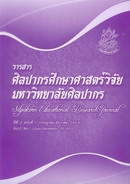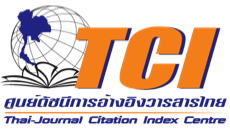การศึกษาสภาพการณ์ของการท่องเที่ยวเชิงศิลปวัฒนธรรมในจังหวัดนครปฐม
บทคัดย่อ
บทคัดย่อ
การวิจัยครั้งนี้มีวัตถุประสงค์ 1) เพื่อศึกษาสภาพการณ์ของการท่องเที่ยวเชิงศิลปวัฒนธรรมของจังหวัดนครปฐม 2) เพื่อเปรียบเทียบระดับความพึงพอใจของนักท่องเที่ยวเชิงศิลปวัฒนธรรมของจังหวัดนครปฐมตามลักษณะส่วนบุคคล 3) เพื่อศึกษาปัญหา/อุปสรรคและข้อเสนอแนะต่อการท่องเที่ยวเชิงศิลปวัฒนธรรมของจังหวัดนครปฐม ระเบียบวิธีการวิจัยแบบผสมผสานวิธี (Mixed Method Research) 2 ขั้นตอน คือ ขั้นตอนที่ 1 การวิจัยเชิงปริมาณ ประชากรที่ใช้ในการวิจัยครั้งนี้ เป็นนักท่องเที่ยวชาวไทยที่มาท่องเที่ยวในจังหวัดนครปฐม จำนวน 712,117 คน กลุ่มตัวอย่าง จำนวน 400 คน สุ่มตัวอย่างแบบหลายขั้นตอน (Multi-stage Random Sampling) เครื่องมือที่ใช้เป็นแบบสอบถาม สอบถามนักท่องเที่ยวชาวไทย มีค่าเชื่อมั่น (r) = .9416 ขั้นตอนที่ 2 การวิจัยเชิงคุณภาพ ใช้การสนทนากลุ่มกับผู้มีส่วนได้ส่วนเสีย (Stakeholders) จำนวน 20 คน โดยการคัดเลือกแบบเจาะจง (Purposive Sampling) วิเคราะห์ข้อมูล สถิติที่ใช้ ร้อยค่า ค่าเฉลี่ย ส่วนเบี่ยงเบนมาตรฐาน ทดสอบที และทดสอบเอฟ และวิเคราะห์ข้อมูลเชิงคุณภาพ ด้วยการวิเคราะห์เนื้อหา (Content Analysis)
ผลการวิจัยพบว่า 1) สภาพการณ์ของการท่องเที่ยวเชิงศิลปวัฒนธรรมของจังหวัดนครปฐม นักท่องเที่ยวมีวัตถุประสงค์เพื่อการพักผ่อน/ท่องเที่ยว ร้อยละ 60.00 ระยะเวลาในการท่องเที่ยว ส่วนใหญ่ใช้เวลา 1 วัน ร้อยละ 67.50 จำนวนครั้งที่มาท่องเที่ยวมากที่สุด มากกว่า 5 ครั้ง ร้อยละ 41.5 ลักษณะการท่องเที่ยวแบบไป-เช้าเย็นกลับ ร้อยละ 84.00 มีพฤติกรรมท่องเที่ยว วัด โบสถ์ อุทยานประวัติศาสตร์มากที่สุด ร้อยละ 52.00 นิยมท่องเที่ยวเชิงศิลปวัฒนธรรมมากที่สุด ร้อยละ 25.50 แหล่งท่องเที่ยวที่นิยม คือองค์พระปฐมเจดีย์มากที่สุด ร้อยละ 46.50 มีความพึงพอใจในการจัดการท่องเที่ยวเชิงศิลปวัฒนธรรมในภาพรวมอยู่ในระดับมาก (=3.58) 2) เปรียบเทียบความพึงพอใจในการจัดการท่องเที่ยวเชิงศิลปวัฒนธรรม ของนักท่องเที่ยว จำแนกตามช่วงอายุ ระดับการศึกษา รายได้ และอาชีพมีความพึงพอใจในการจัดการท่องเที่ยวเชิงศิลปวัฒนธรรม แตกต่างกันอย่างมีนัยสำคัญที่ระดับ .05 แต่นักท่องเที่ยวที่มีเพศ และสถานภาพสมรสแตกต่างกัน มีความพึงพอใจในการจัดการท่องเที่ยวไม่แตกต่างกัน 3) ปัญหา/อุปสรรคและข้อเสนอแนะต่อการท่องเที่ยว ได้แก่ การเดินทางไม่สะดวก ภูมิทัศน์และความสะอาดของสถานที่ท่องเที่ยว ขาดความรู้แหล่งท่องเที่ยว การประชาสัมพันธ์ การบริการของเจ้าหน้าที่ การขาดการมีส่วนร่วมต่างคนต่างทำ และขาดการสนับสนุนจากหน่วยงานของรัฐ การสื่อสารให้ความรู้และภาษา การบริการอาหาร/เครื่องดื่ม และการบริการของที่ระลึก รวมถึงการติดตามและประเมินผล
Abstract
This research was aimed to analyze the situations of cultural and art tourism in Nakhon Pathom and to compare the levels of customer satisfaction among the tourist groups according to their different personal characteristics. This also investigated to its occurring problems, obstacles and recommendations. Based on the integrated methodologies comprised of the 2 practical steps, the quantitative method was first employ the structured questionnaire with the 400 Thai tourist respondents whom were randomly selected from the total population (712,117 persons) by the multi-stage random sampling technique. After that the 20 stakeholders were purposely invited to participate in the focus group discussion setting to provide their qualitative data. Respectively the gathered data was quantitatively and qualitatively analyzed. The collected data was analyzed and presented in percentage, mean and standard deviation t-test ,F-test and the content analysis technique.
By largely the respondents said that they wanted to have their relaxation and enjoyableness with this trip (60.00%) and this was happened on their daily or one day tour (67.50%). They therefore preferred to arrive and tour the province in the morning and came back later in the evening (84.00%). A little bit more than forty percent of them had visited the province ≥ 5 times. For the most favorable tourist sites they were the Buddhist sanctuary and temples in additional to the historical parks (52.00%). Generally 25.50% was favored of this cultural and art tourism and 46.50% would most visit Phra Prathom Jedi (the big pagoda). For the overall situations they satisfied to the supply chain at the large level (X=3.58). Furthermore the characteristics as age, education, income, and occupation variables were significantly associated with the satisfaction (P ≤ .05).
For the problems and obstacles founded here were that the traveling was inconvenient, some of the tourist sites had some of the problems in its landscapes and cleanliness. There had the shortage of its knowledge and public information, government and private services such as guides, languages, foods and drinks which were already served to the tourist groups. Under the low supports from the government it yielded to the stakeholders or many sectors to have their low participation with these actions. May parts of them still had their work fragmentation with this.





